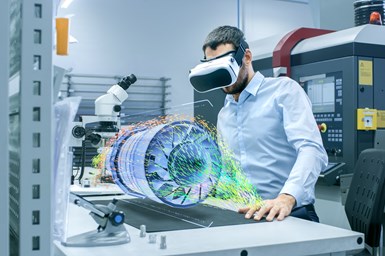Spatial Computing, AI Meet the Machine Shop
Artificial intelligence and the spatial computer have enormous potential to change the way machine shops will operate in the future.
Share



Ten years ago, Google created a pair of glasses that got me very excited about the future of machining. Most people related it to gaming and artificial reality, but the far-reaching implications and promising advancements this technology could bring to our industries and machine shops was never fully realized. Google stopped its glasses project suddenly, which was a great disappointment for me.
Recently, Apple released the Vision Pro to the market, which coincided with a greater push in the world of artificial intelligence (AI). From this, we are about to see a dramatic change in the way machine shops will operate in the future. The potential for growth is enormous. Here are some examples of areas where this technology could advance machine shops:
Servicing equipment. In the past, when a service technician came to our facilities, they came with few diagnostic tools, hand tools and a cell phone. Then, the process of diagnosing what is wrong and finding out how to fix it began. The status of machines was assessed and, in many cases, if the problem was not clear, then phone calls were made and out came the reference books. This sometimes resulted in lengthy repair processes because of various reasons, including being unfamiliar with the machine and sometimes having a lack of experience. This is where the spatial computer and AI come in.
Through AI, the spatial computer can pull up schematics and interpret error codes faster than any human. The spatial computer can also connect to other spatial computers for virtual conversations and diagnostics with off-site experts in real time. All linked computers can look at the problem and work through to a solution. Did I mention real time? Adding and subtracting experts as needed can assist in working through the service problem quickly. Can you imagine how much faster service could be if personnel were readily accessible through the spatial computer, rather than having to commute and be on site at your physical location?
This is going to change the way we see service. Spatial computing, with the assistance of AI, may even put service into the hands of machine shops so they can fix the problem faster themselves.
Programming CNC machines. Can you imagine programming in a virtual world with spatial computing and AI? I can see how quickly it opens up the possibilities for machine shops. Let’s start by being able to see a part being machined in real time both virtually and in 3D. This will improve the accuracy of programming and bring programs to a higher level of reliability, because it will be able to calculate tool pressures and cutting issues based on the expansive databases available to it. Imagine creating optimized, error-free programs which have been proven in a 3D, virtual environment. With this virtual reality and the assistance of AI, the programmer will be able to simulate many approaches to programming to create optimized pathways using virtual simulations without impacting the shop’s machining time. Think about how often machine shops have wasted time optimizing programs on the shop floor when they could be running parts and making money!
Machinist operating equipment. Here is where the technological advancements will become very interesting. Imagine what spatial computing and AI will do for the machinist setting up and running a CNC machine. It will bring this activity to a new level. The spatial computer will allow the machinist to actively monitor the equipment in real time, including the control and the inside of the machines, while they are working. More than one machine can be monitored at a time from anywhere in the shop or the world. Let that sink in! Machinists can not only monitor the machines, but also do detailed setups from virtual lists or instructions accessed with the assistance of the spatial computer. This is all done at the same time. The AI in the spatial computer can also list detailed visual or aural instructions to accomplish these tasks if necessary.
When it comes to checking parts, the spatial computer can observe and document measurements from the instruments without the machinist writing them down. Manual documentation of measurements for quality control purposes will become unnecessary. Can you imagine a machinist that can monitor, record and have access to the world’s information while operating machines from anywhere in the world?
The world of spatial computing and AI has begun. Will all of this be available right away? Maybe! Or maybe not. The point is that it is coming, and machine shops will need to be ready for it. Just like in surfing, this is going to be a big wave, and you better be ready to catch it!






















